Gayle A. Pritchard's Blog, page 5
October 28, 2015
Building a Composition
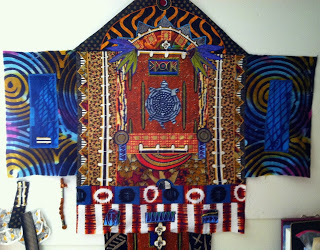 Turtle Spirit II, in progress
Turtle Spirit II, in progressby Gayle PritchardIn my previous post, the central panel of Turtle Spirit II was finished. By showing you the piece on my working wall here, I hope you can get a sense of how the finished composition was built, piece by piece, literally.
As I mentioned before, I sew my compositions in sections on a tear-away backing. This makes it easier to work with the sections on my sewing machine, and it allows me to join unusually shaped edges to each other with ease.
To the base composition, I have added two side panels of African fabric, each of which features one of my hand-made cyanotype prints appliqued in place. I already envision how I want to quilt these side panels with long, broad stitches in perle cotton, and can hardly wait to begin sewing them! Along the bottom of the original panel is a single piece of unusual striped fabric, to which I have pinned various fabric remnants to be appliqued in place. I like this method of working. It is the same process as when I create a paper collage. The elements are auditioned by placing them on the main composition where it is very easy to immediately see what does or doesn't work. The finished art quilt will also have an additional layer of design, which is the quilting stitch itself. Unless you make quilts, it's hard to describe how much adding that line to the surface of the piece can change the surface, directing the eye in unexpected directions. I can also later add additional layers of fabrics and surfaces, such as stitched and printed attachments, to further enhance and complete the composition. I can respond to the composition throughout each stage of the process, adding and taking away until the piece is finished. All of these potential features are in my mind as I place the elements for this layer of the finished work.
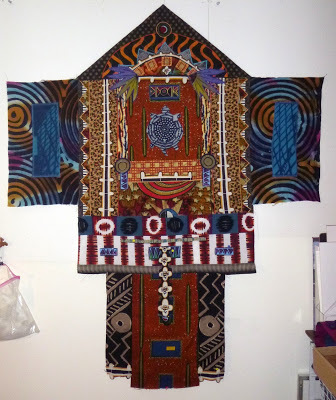 The base layer of Turtle Spirit II, almost done!
The base layer of Turtle Spirit II, almost done!To the striped bottom edge of the top's center panel, I added a narrow strip of fabric to create a visual edge. Underneath, a section of African fabric matching the top central panel is repeated, edged on either side with an exciting fabric that has a directional design, and more snippets laid on the surface to consider for applique.
Considering future structural problems, I decide that the two bottom side edges need a fabric underneath them to make it easier to bind the finished quilt when the layers are assembled. (Trying to bind those shaped side edges is a problem I definitely wish to avoid!) I don't want the fabric I use to jump out visually, though, because I like the illusion of the sides being slightly shorter than the bottom central panel. My solution is in the next picture. Ignoring the purple and blue backing fabric, which will not show on the front when the piece is finished, can you tell what I added or changed?
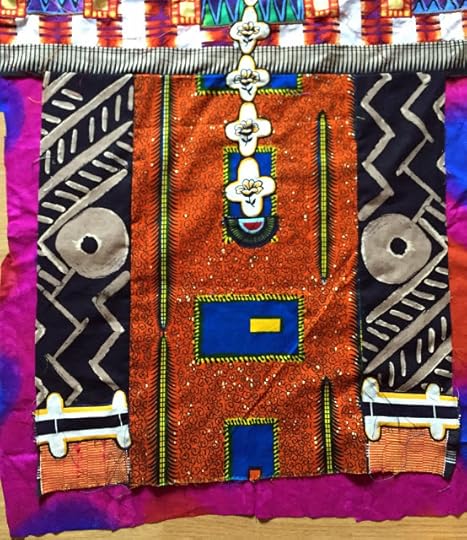
Published on October 28, 2015 12:48
October 23, 2015
Grounded Like a Turtle
 Detail, Turtle Spirit, ca. 1995I mentioned in my last post that I was finishing up some odds and ends around my studio. One of those pieces is a Turtle Spirit quilt. I had made one as a commission for a wedding 20 years ago, and a detail of it is shown at left. Turtle is a symbol of mother earth, fertility and feminine wisdom. You can see on the detail shot that I included embellishments representing rabbits as a wish for the new couple to produce the children they desired. Sure enough, two beauties came from the union!
Detail, Turtle Spirit, ca. 1995I mentioned in my last post that I was finishing up some odds and ends around my studio. One of those pieces is a Turtle Spirit quilt. I had made one as a commission for a wedding 20 years ago, and a detail of it is shown at left. Turtle is a symbol of mother earth, fertility and feminine wisdom. You can see on the detail shot that I included embellishments representing rabbits as a wish for the new couple to produce the children they desired. Sure enough, two beauties came from the union!In our family, we have long enjoyed Sams and Carson's Medicine Card deck. At our get-togethers, the spiritually inclined women gather around a spread, and take turns reading the interpretation to the seeker, spending hours discussing the wisdom uncovered to guide our paths. Since turtle is considered to be the personification of goddess energy, I find her to be a powerful symbol. She protects and invites us to go inside ourselves to connect and be grounded. I wanted my own Turtle Spirit quilt. After I finished the commission, I started one for myself and never got around to finishing it. Ah, but Turtle has reappeared in my life this year, and I am driven to finish the new piece and hang it on my wall.
 Turtle Spirit by Gayle Pritchardca. 1995. This is the originalcommissioned artwork.
Turtle Spirit by Gayle Pritchardca. 1995. This is the originalcommissioned artwork.For my Turtle Spirit, I began with essentially the same central panel, a turtle form cut from hand made shibori fabric, hand appliqued in place on a remnant of one of my favorite African fabrics. I then cut and pinned additional design elements in place on my studio wall until I was pleased with what was happening. If you look closely, you will see cut-out snippets of fabric as well as border strips used to make the design larger.

The central portion of the new Turtle Spirit, shown above left, measures about 25" wide x 30" high, to give you an idea of the scale. If you examine the edges, you will notice the tear-away backing showing. I create all of my fiber collages on top of a non-fusible medium weight tear-away backing. It not only provides body while sewing, it also allows me to create shaped pieces that fit together like a jig-saw puzzle without making any patterns.
In my next post, I will show you how I built my final composition, beginning with this little panel. The piece is almost finished now, and I can't wait for you to see it! I can't wait to hang it up on the wall.
Published on October 23, 2015 07:55
August 31, 2015
Wrapping Things Up
 This pretty journal, just finished, is in my
This pretty journal, just finished, is in myetsy shop, NoMoonNight.I have been finishing up unfinished work over the past month, and it feels good to wrap things up. I have a stack of tri-fold journals in various stages of completion, like the pretty shibori one in the picture. They have hand crafted fabric that is quilted, plenty of journaling pages and unique wrap closures, speaking of wrapping things up!
These make great gifts, by the way! I also decided to put together Tri-fold Journal Kits, and will have them for sale at NoMoonNight soon. I had them bagged with the instructions, and Gail and Jill in my artist group reminded me to put a picture on the front. Duh! Great idea, and that's what friends are for! My son Brian is helping me put a "how-to" tutorial together, as well, so stay tuned.
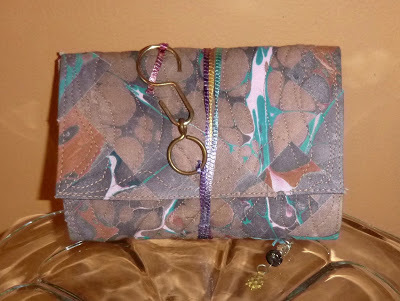 Here is a pretty tri-fold journal with hand marbled fabric
Here is a pretty tri-fold journal with hand marbled fabricand a unique wrap closure. I have more journals in my shop.
Published on August 31, 2015 06:28
August 9, 2015
Being Where You Need To Be and Other Plans
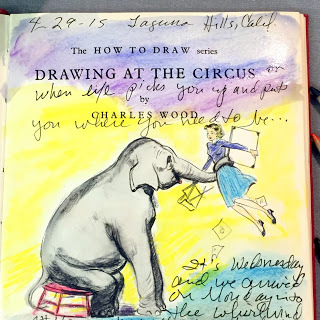 As John Lennon wrote, "life is what happens when you're busy making other plans." Planning, in and of it self, is fraught with danger, and life often simply does not cooperate.
As John Lennon wrote, "life is what happens when you're busy making other plans." Planning, in and of it self, is fraught with danger, and life often simply does not cooperate.And so, that is how my spring and summer went: plans gone awry as real life took over and went sideways. How appropriate it was that I picked an old circus book to use as a journal for the summer. Life has been like a three-ring circus! As a result of care-taking demands in this circus, I have not have much time to make art.
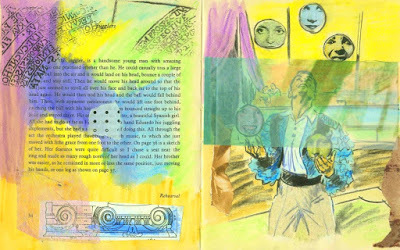 Sometimes, there is only time to juggle the many things you need to do. Don't be discouraged. Remember, this crazy time isn't forever. Do what I do, and squeeze art-making time into your day. I have been organizing, finding and finishing up already started pieces that don't require a lot of thinking time.
Sometimes, there is only time to juggle the many things you need to do. Don't be discouraged. Remember, this crazy time isn't forever. Do what I do, and squeeze art-making time into your day. I have been organizing, finding and finishing up already started pieces that don't require a lot of thinking time.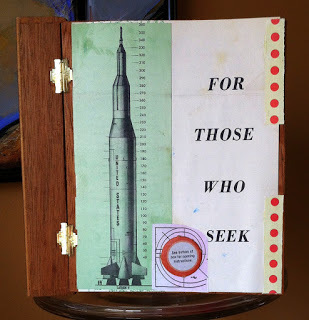 This is the "in progress" front cover of an assemblage I am finishing.
This is the "in progress" front cover of an assemblage I am finishing.I am so grateful, too, that I have a supportive group of artist friends. We meet almost every week. It is something to look forward to, and an appointment to think, be and make art.
Published on August 09, 2015 06:54
April 26, 2015
Ready, Set, Go: Traveling Art Supplies
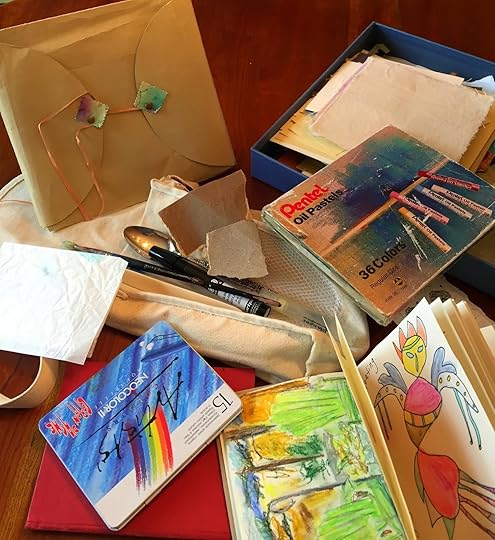 Here is what I want to bring!
Here is what I want to bring!I need to made a new portfolio,
though. My old one, upper left,
is worn out. It's time to decide what I can realistically bring with me, and what I cannot. I want to bring my large, daily journal, but it's too big and heavy, so I pulled out the smaller one, shown in the picture at the bottom. Even that one is too thick, and takes up too much room. Instead, I am bringing my "circus" book to use as a daily journal, and for collage. It is an altered book my dear friend Lois gave me years ago, and I have traveled with it previously. Time to finish it. It is the perfect venue for journaling now, since I feel like a plate spinner in the circus!
Now, to make a new portfolio. How, you ask? Decide if you want a square or rectangular one, mark off the dimensions on a nice, thick stock or, as I used, watercolor paper, and grab a metal ruler and a bone folder.
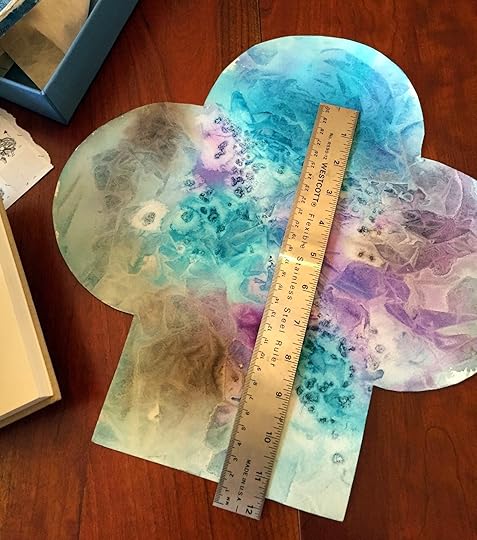 On my hand-painted watercolor paper, I marked a 7" square, then, using a compass (you can use a large bowl, too!), I marked 3.5" scallops. Next, I added lines for an additional 1/4" outside of the 7" square. That gives the portfolio some thickness for holding the papers I will pack.
On my hand-painted watercolor paper, I marked a 7" square, then, using a compass (you can use a large bowl, too!), I marked 3.5" scallops. Next, I added lines for an additional 1/4" outside of the 7" square. That gives the portfolio some thickness for holding the papers I will pack.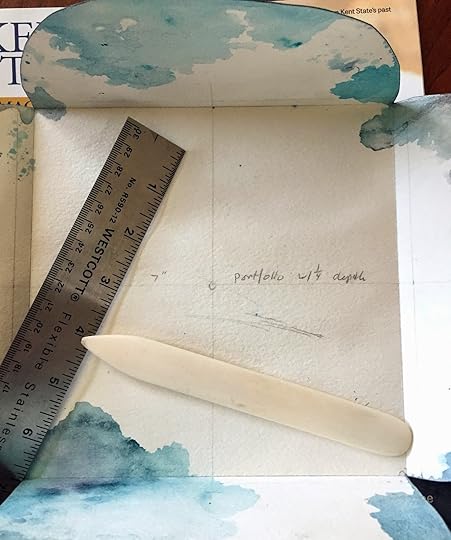 Mark the dimensions, trim and fold using a
Mark the dimensions, trim and fold using ametal ruler and a bone folder. I added a set
of double lines, 1/4" apart, for depth.You can close this type of portfolio by just overlapping the scallops, but I decided to recycle the tabs and ribbons from my old portfolio and use those. Since I have a grommet tool and a ton of pretty, colored grommets, I pulled those out and picked a pretty blue color to match.
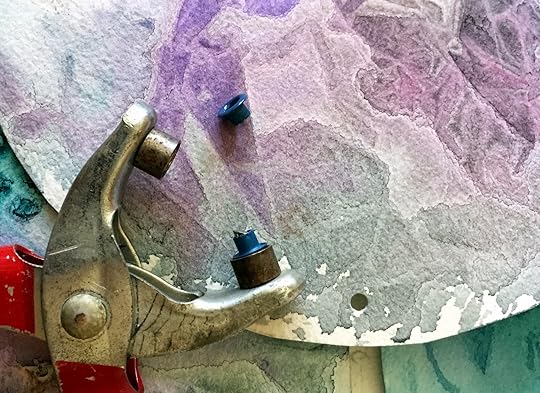 This tool punches and attaches a grommet all at once.
This tool punches and attaches a grommet all at once.I don't even know where I got it, but have had it
forever. It is a handy-dandy tool!
Squeeze and attach the grommets. Insert knotted ribbons through my hand-painted tabs. Choose loose drawing papers and some collage scraps to put inside. I'm not on vacation; this is a serious, personal trip, and isn't about making art. I'm packing light compared to what I normally would bring.
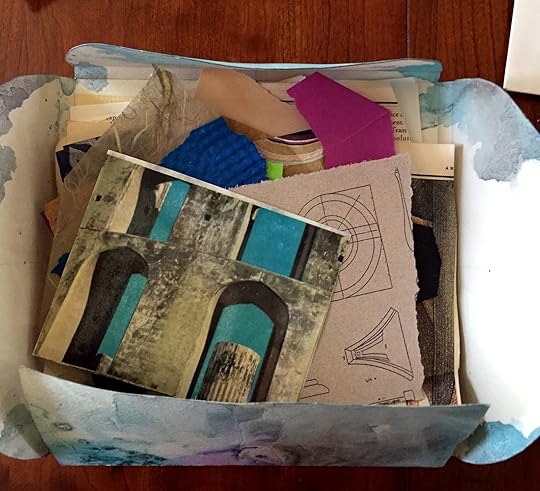 Hurrah, they all fit!
Hurrah, they all fit!
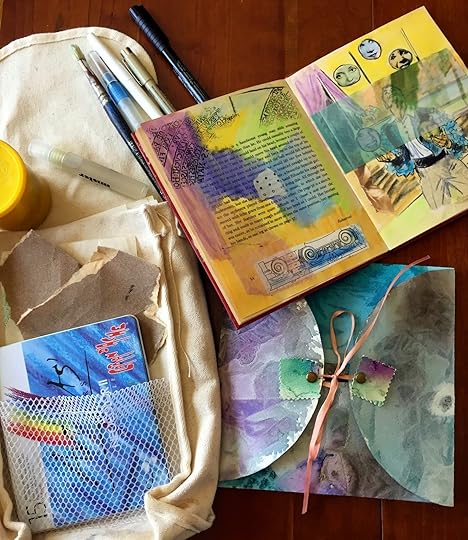
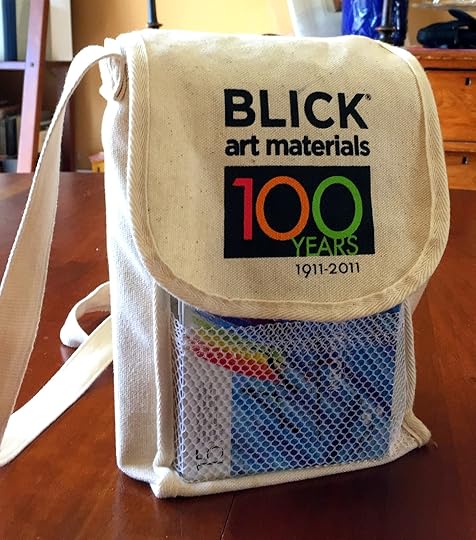 All set! My selected art supplies and new portfolio of papers all fit in this nifty bag my friend Gail gave to me. That, in turn, will take up little space in my luggage. Sometimes being limited in what you have to use forces creative responses. I'm counting on it!
All set! My selected art supplies and new portfolio of papers all fit in this nifty bag my friend Gail gave to me. That, in turn, will take up little space in my luggage. Sometimes being limited in what you have to use forces creative responses. I'm counting on it!
Published on April 26, 2015 07:13
April 19, 2015
Planes, Trains and Automobiles: Artist Travels
 Don't forget your journal! This isone of my refillable matchbox journals, made entirely of recycledmaterials.As I prepare to be on the road, I am reminded of one of the workshops I teach called Planes, Trains and Automobiles: Techniques for Traveling Collages. When you are traveling, you cannot possibly bring all of your art supplies with you. I have perfected a little traveling kit that I like to use, and have found over the decades, that both the familiarity of what I pack combined with the limitations of what I am able to pack combine for some fun inspiration. If you only bring one thing, though, make sure you bring a journal / sketchbook!
Don't forget your journal! This isone of my refillable matchbox journals, made entirely of recycledmaterials.As I prepare to be on the road, I am reminded of one of the workshops I teach called Planes, Trains and Automobiles: Techniques for Traveling Collages. When you are traveling, you cannot possibly bring all of your art supplies with you. I have perfected a little traveling kit that I like to use, and have found over the decades, that both the familiarity of what I pack combined with the limitations of what I am able to pack combine for some fun inspiration. If you only bring one thing, though, make sure you bring a journal / sketchbook! I made this collage while sitting at the beach.
I made this collage while sitting at the beach.With just a few supplies, you can observe and respond to your environment through your artwork, and have a special record of your travels at the same time!
So, what to bring? Do: Grab a journal that is a convenient size. Drill, hole-punch, stitch, pre-paint or fold pocket pages into some of the pages. Don't: try to bring large or heavy tools. Do: Make a checklist of what you are packing. This will make it easier next time. Don't: bring any potential "weapons" on the plane, if you are flying. Pack scissors, needles or anything else like that in your checked luggage. Do: Use the zipper pouch in your suitcase for art supplies.
In my workshop, I show students how to make a petal-fold portfolio in any size to hold their art papers. Any little travel bag will work, however. You can add a place to hold pencils, pens, brushes and markers by stitching or super-gluing rubber bands, hair elastics or sewing elastic. If you use buttonhole elastic, you can fill all those little holes with different tools and supplies.
I will take some pictures as I pack my materials to show you what I bring along. If I can, I always bring a strip of self-adhesive photo corners, a few brass brads, some folded waxed paper, small scraps of matboard, a small container of Yes! glue, a few brushes, pencils and pens, a tin of watercolor crayons or pencils, a tin of oil pastels, a sewing needle, including one I can use to poke holes, colored embroidery floss, some Tear Away, a bone folder, a glue stick, a pair of small paper scissors, 1 small container of white paint, 2 mini-spray bottles, one for water and one for rubbing alcohol, a xylene colorless blender with a small metal spoon, some black and white photocopies for transfer, some throw-away pictures and, finally, a few small strips of fine grade sandpaper. It all fits in a tiny little bag, and fits, next to my portfolio of collage papers, right into my zipper pouch of checked baggage. I am good to go!
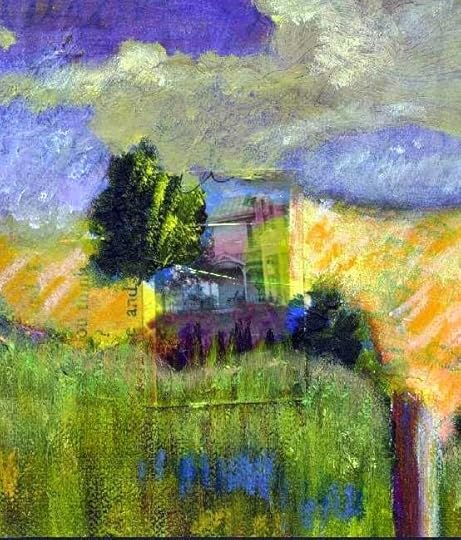 I applied oil pastels over part of an old painting on
I applied oil pastels over part of an old painting on canvas board that I had cut up to bring along on a trip. I
made my collage right on top while I was out on the road.
Published on April 19, 2015 13:19
April 10, 2015
And Another Thing
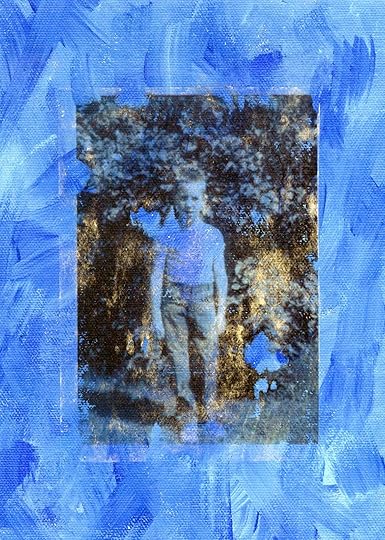 This is an acrylic medium transfer
This is an acrylic medium transferonto painted canvas of an old black
and white photograph.I have been diligently cleaning both my office and my studio (yes, I am lucky to have two separate rooms!) As I sort files and fabrics, I am focused on what type of work I want to concentrate on as I go forward. By framing my sorting that way, I am able to acknowledge, for example, a techniques book that I have loved and re-read numerous times over the years, but that, realistically, is not something I plan to work with moving forward.
It is empowering to focus my energies and claim the many unfinished pieces and exciting work I plan to create, while also letting go of pieces I will never finish (they sometimes get upcycled into another form), and passing along books or fabric to someone else who is passionate to use them right now!
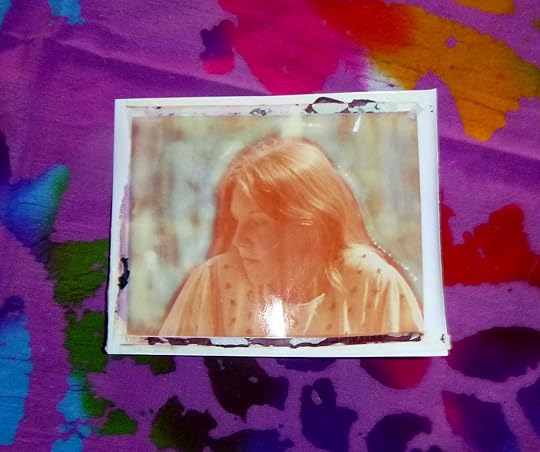 The throw-away remainder of a Polaroid transfer
The throw-away remainder of a Polaroid transferIn sorting through my stack of Polaroid transfers that I was preparing with mats to list on etsy, I found the image at left, me in France many moons ago. This print is what remains on the Polaroid film after the image has been transferred to another surface. Much of the color is gone, often leaving a faded looking and intriguing after image. I mention it because, in my last post, I was showing you how I alter old photographs by scratching them up and adding color back to the surface.
This image has been altered by scratching with a sharp, thin awl, which you can see best if you look at the edge around the right-hand shoulder and head area. The background was altered using a Q-tip dipped in bleach, spread over the area to be changed, then rinsed off. Bleach can be used with a spray bottle, as well, or in the form of a bleach gel as found in many cleaning products. Just make sure you have good ventilation, gloves and an area that is easy to wipe down. Better yet, do it outside when the weather is nice!
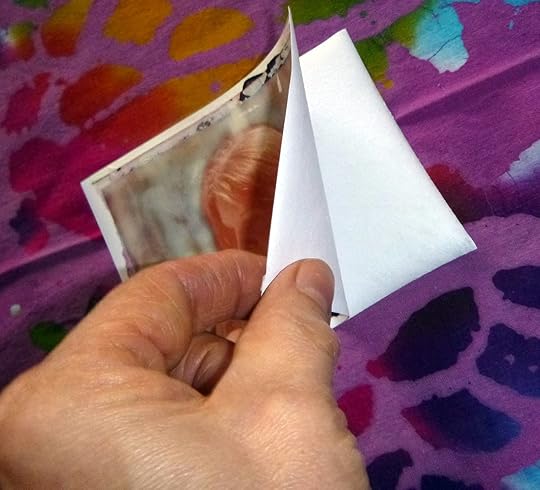
To complete the image for use in collage, I peel away the thick paper backing from photographs. By removing the extra paper, the photograph becomes more pliable, like a piece of fabric. It is easier to keep flat if you are using glue to adhere it, fun to machine stitch in place onto another surface, and thin enough not to make your fingers bleed if you are hand stitching it down.
Now, go immediately to your studio and play! Can't wait to hear what you've done with these ideas. I'll be in touch when I find more altered images in my cleaning.
Published on April 10, 2015 10:59
March 29, 2015
Using Throw-Away Pictures in Collage, Part 2
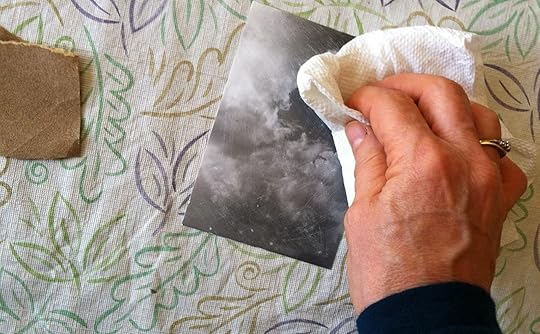 Wipe off the grit from the sandpaper before adding color In my last post, we had sand-papered the throw-away photo of clouds. Next, take a slightly damp paper towel and wipe away the powdery grit, see how the lines from the sandpaper look, and add more if you want to. If not, you are ready to add color.
Wipe off the grit from the sandpaper before adding color In my last post, we had sand-papered the throw-away photo of clouds. Next, take a slightly damp paper towel and wipe away the powdery grit, see how the lines from the sandpaper look, and add more if you want to. If not, you are ready to add color.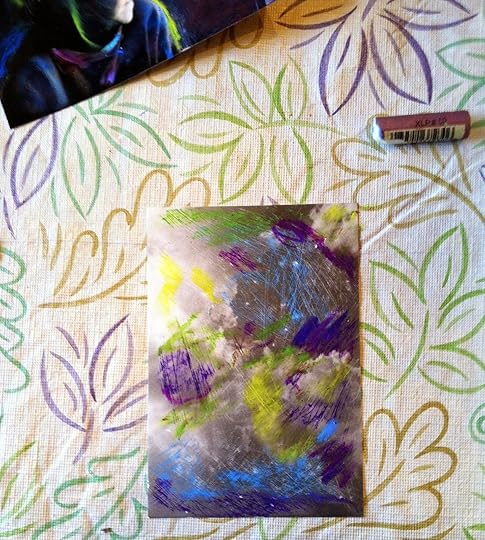 Add colors wherever you want, but especially over the lines.
Add colors wherever you want, but especially over the lines.I usually use oil pastels, my go-to art supply, but you can try inks, for example, or other supplies you have on hand that can be rubbed into the scratches. Keep in mind if you use anything powdery, like soft pastels, you'll have to use a fixative on them later. Here, you can see that I have added various oil pastel colors to my scratched photograph. On the table in the upper right is a blender, another handy tool for use with oil pastels. It mixes colors without changing their intensity.
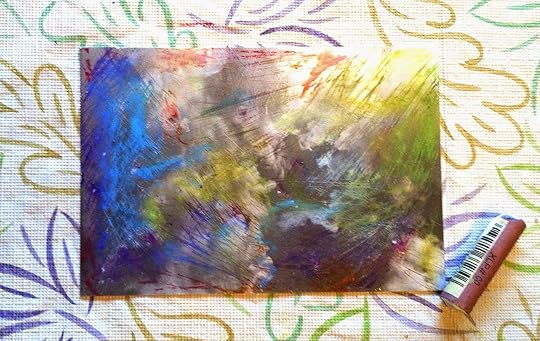
I use my fingers to blend, wipe off, and push the color into the scratches, and adding more color if I feel like it. If you are one of those people who doesn't like to get your hands dirty, use a make up sponge to blend.
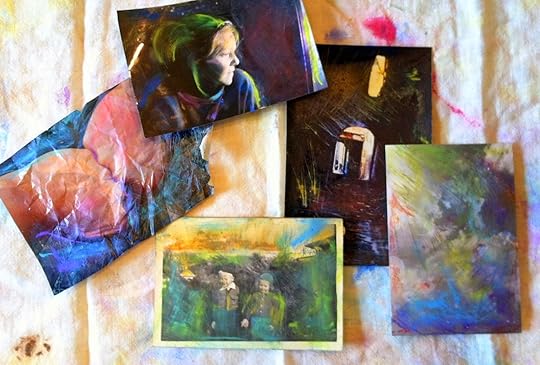 A group of altered photographs ready to use. On the far left, the
A group of altered photographs ready to use. On the far left, thephoto of my hands tore as I peeled it. All the better!That's really all there is to it. It's easy to use throw-away pictures or glossy magazine images to create your own collage papers. All that remains now is to peel the paper backing off the back of the photo. I do this because it makes the photo more like paper, making it easier to glue or stitch it in place on your collage. Just pick a corner, and start to peel. If it's an old picture, you might need to mist it a little bit with water to pick the backing off. Once it is peeled, you can dampen and crumple it, adding further lines to the surface. That's how I treated the Eiffel Tower photo, below. I then tore it up to fit the mat that I had.
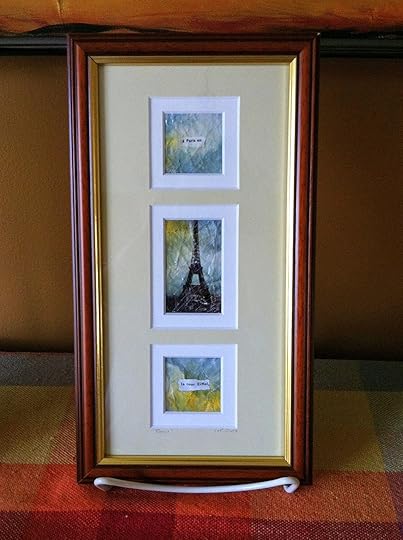 La Tour Eiffel, in Paris. This collage was created with an altered, sand-papered photo.
La Tour Eiffel, in Paris. This collage was created with an altered, sand-papered photo.This collage, and others, are available in my etsy shop, NoMoonNight.
Published on March 29, 2015 07:54
March 25, 2015
Using Throw-away Pictures in Collage, Part 1
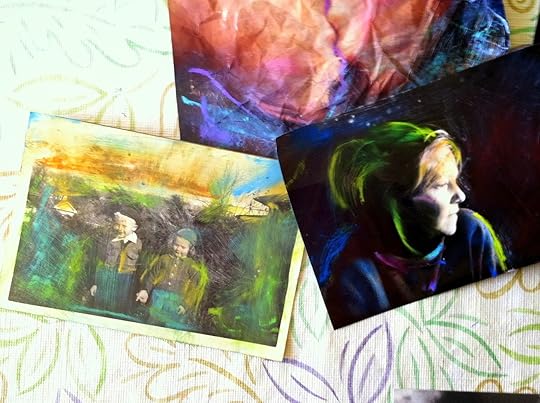 I love making collages, and I have a little secret for you: even though I am known as a fiber artist, I consider everything I do to be collage. I absolutely love the gathering and sorting of snippets, whether they are pieces of fabric, found objects or paper ephemera. Old pictures are no exception.
I love making collages, and I have a little secret for you: even though I am known as a fiber artist, I consider everything I do to be collage. I absolutely love the gathering and sorting of snippets, whether they are pieces of fabric, found objects or paper ephemera. Old pictures are no exception. I have an entire box full of what I call throw-away photographs: you know, the ones that used to come in a pack of printed film (yes, pre-digital era!). When film was developed, they didn't just print the good images; you got them all, and it was up to you to throw them away. I started saving them for use in my workshops so that I could pass them out to all the students to try our techniques. Over the years, I have made some amazing work with these throw-away pictures, so I thought I would show you how I alter them.
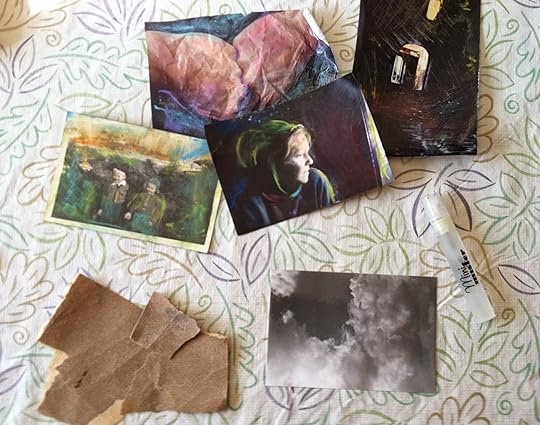 A recent grouping of pictures pulled from my box
A recent grouping of pictures pulled from my boxFirst, you'll need an old, crappy picture to practice on. You will also need very fine grade sandpaper and a damp paper towel. Down the road in this process you'll see how the little spray mister is used, and how I added color. But for today: first things first!
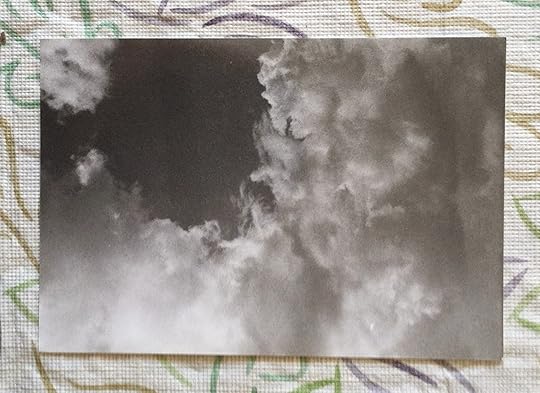 This black and white picture of clouds is a good one to use. It has little character by itself, but also has a lot of areas ready for scratching up with the sandpaper. Don't get bogged down picking an image. Just grab one. Even a magazine image or a page from an old book will work, as long as the paper isn't too fragile.
This black and white picture of clouds is a good one to use. It has little character by itself, but also has a lot of areas ready for scratching up with the sandpaper. Don't get bogged down picking an image. Just grab one. Even a magazine image or a page from an old book will work, as long as the paper isn't too fragile.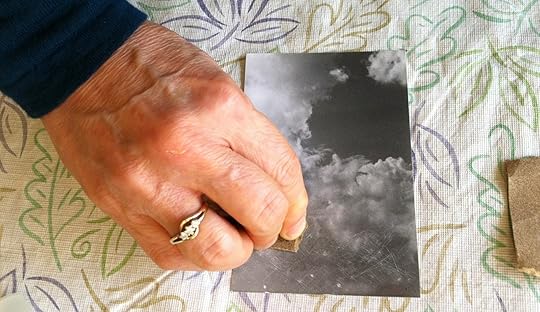 I usually fold up a small piece of the sandpaper, then use it to scrub, scratch and draw on the surface. The direction of the scratch marks as well as their length will become visible later, so have fun with this part.
I usually fold up a small piece of the sandpaper, then use it to scrub, scratch and draw on the surface. The direction of the scratch marks as well as their length will become visible later, so have fun with this part.Next time: adding color
Published on March 25, 2015 13:10
March 17, 2015
Stir Crazy and Wanting Spring
 A page from my sketchbook, and a
A page from my sketchbook, and areminder of spring, even in black
and white!After weeks of slogging through the end-of-winter doldrums, the latest snowstorm stopped me dead in my tracks. I admit it. It the time of year in Ohio when I can no longer wait for spring to arrive, and I have officially gone stir crazy.
I was productive for weeks, doing my sunprinting and working on several new art pieces while also finishing up some pieces I have had laying around in my studio for quite awhile, including Bluebell / First Place.
No, I haven't forgotten about my Grandma prints. Did I mention that I have been housebound by the weather? On the desk by the front door is everything I need to get the images of Grandma enlarged, so I can make a giant collage that I will then print from. I just haven't been motivated to run across town in this horrible weather.
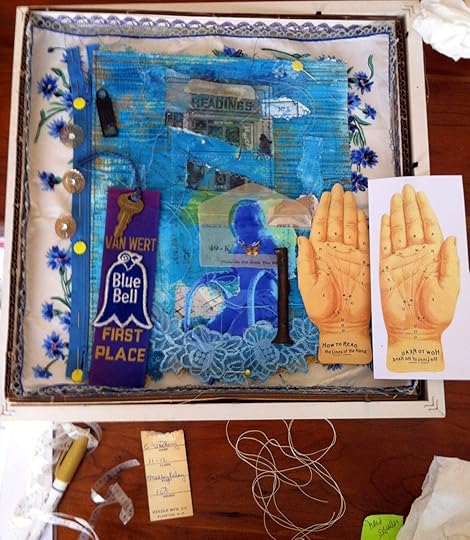 Bluebell / First Place was started as a collage made
Bluebell / First Place was started as a collage madeduring a playday with artist friends. Time to finish it!
So, I am reassured, as signs of spring appear under melting snow. Here's hoping!
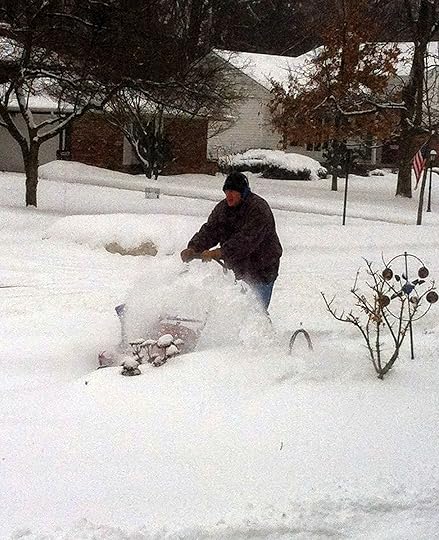 My husband experiencing the end of winter blues.
My husband experiencing the end of winter blues. I, for one, can't take much more.
Published on March 17, 2015 07:52



